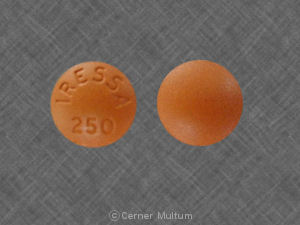Iressa Dosage
Generic name: GEFITINIB 250mg
Dosage form: tablet, coated
Drug class: EGFR inhibitors
Medically reviewed by Drugs.com. Last updated on Feb 18, 2025.
Patient Selection
Select patients for the first-line treatment of metastatic NSCLC with IRESSA based on the presence of EGFR exon 19 deletions or exon 21 L858R mutations in their tumor or plasma specimens. If these mutations are not detected in a plasma specimen, test tumor tissue if feasible.
Information on FDA-approved tests for the detection of EGFR mutations in NSCLC is available at: http://www.fda.gov/CompanionDiagnostics.
Recommended Dose
The recommended dose of IRESSA is 250 mg orally once daily with or without food until disease progression or unacceptable toxicity.
Do not take a missed dose within 12 hours of the next dose.
Administration to Patients Who Have Difficulty Swallowing Solids
Immerse IRESSA tablets in 4 to 8 ounces of water by dropping the tablet in water, and stir for approximately 15 minutes. Immediately drink the liquid or administer through a naso-gastric tube. Rinse the container with 4 to 8 ounces of water and immediately drink or administer through the naso-gastric tube.
Dose Modification
Dose Modifications for Adverse Drug Reactions
Withhold IRESSA (for up to 14 days) for any of the following:
- •
- Acute onset or worsening of pulmonary symptoms (dyspnea, cough, fever)
- •
- NCI CTCAE Grade 2 or higher in ALT and/or AST elevations
- •
- NCI CTCAE Grade 3 or higher diarrhea
- •
- Signs and symptoms of severe or worsening ocular disorders including keratitis
- •
- NCI CTCAE Grade 3 or higher skin reactions
Resume treatment with IRESSA when the adverse reaction fully resolves or improves to NCI CTCAE Grade 1.
Permanently discontinue IRESSA for:
- •
- Confirmed interstitial lung disease (ILD)
- •
- Severe hepatic impairment
- •
- Gastrointestinal perforation
- •
- Persistent ulcerative keratitis
Dose Modifications for Drug Interactions
Strong CYP3A4 Inducers
Increase IRESSA to 500 mg daily in the absence of severe adverse drug reaction, and resume IRESSA at 250 mg seven days after discontinuation of the strong CYP3A4 inducer.
More about Iressa (gefitinib)
- Check interactions
- Compare alternatives
- Pricing & coupons
- Reviews (8)
- Drug images
- Side effects
- During pregnancy
- Generic availability
- FDA approval history
- Drug class: EGFR inhibitors
- Breastfeeding
- En español
Patient resources
Professional resources
Related treatment guides
See also:
Further information
Always consult your healthcare provider to ensure the information displayed on this page applies to your personal circumstances.


